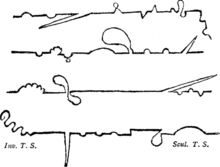Sparkline
A sparkline is a very small line chart, typically drawn without axes or coordinates. It presents the general shape of the variation (typically over time) in some measurement, such as temperature or stock market price, in a simple and highly condensed way. Sparklines are small enough to be embedded in text, or several sparklines may be grouped together as elements of a small multiple. Whereas the typical chart is designed to show as much data as possible, and is set off from the flow of text, sparklines are intended to be succinct, memorable, and located where they are discussed.
| Index | Day | Value | Change |
|---|---|---|---|
| Dow Jones | 10765.45 | −32.82 (−0.30%) | |
| S&P 500 | 1256.92 | −8.10 (−0.64%) | |
| Sparklines showing the movement of the Dow Jones Industrial Average and S&P 500 during February 7, 2006 | |||
History
In 1762 Laurence Sterne used typographical devices in his sixth volume of The Life and Opinions of Tristram Shandy, Gentleman to illustrate his narrative proceeding:"These were the four lines I moved through my first, second, third, and fourth volumes,–".[1]

The 1888 monograph describing the 1883 eruption of the Krakatoa shows barometrical signatures of the event obtained at various stations around the world in the same fashion, but in separate plates (VII & VIII), not within the text.[2]
In 1983, Edward Tufte had formally documented a graphical style, then called "intense continuous time-series", encouraging extreme compaction of visual information.[4]
In early 1998, interface designer Peter Zelchenko introduced a feature called "inline charts", designed for the PC trading platform Medved QuoteTracker. This is believed to be the earliest known implementation of sparklines.[5]
In 2006, the term sparkline itself was introduced by Edward Tufte for "small, high resolution graphics embedded in a context of words, numbers, images".[6][7] Tufte described sparklines as "data-intense, design-simple, word-sized graphics".[8]
On May 7, 2008, Microsoft employees filed a patent application for the implementation of sparklines in Microsoft Excel 2010. The application was published on November 12, 2009,[9] prompting Tufte[10] to express concern at the broad claims and lack of novelty of the patent.[11]
On 23 January, 2009, MultiRacio Ltd. published an OpenOffice.org extension "EuroOffice Sparkline" to insert sparklines in OpenOffice.org Calc.[12]
Usage
Sparklines are frequently used in line with text. For example:
The Dow Jones Industrial Average for February 7, 2006
.
The sparkline should be about the same height as the text around it. Tufte offers some useful design principles for the sizing of sparklines to maximize their readability.[7]
See also
References
- Laurence Sterne, Life and Opinions of Tristram Shandy, Ann Ward (vol. 1–2), Dodsley (vol. 3–4), Becket & DeHondt (vol. 5–9), 1759-1767
- Symons, G. J., Judd, J. W., Strachey, S. R., Wharton, W. J. L., Evans, F. J., Russell, F. A. R., ... & Whipple, G. M. (1888). The eruption of Krakatoa: And subsequent phenomena. Trübner & Company. Plate VII
- Zelchenko, Peter; Medved, Michael. "Medved QuoteTracker screenshot". Wayback Machine. Internet Archive. Archived from the original on 13 October 1999. Retrieved 1 December 2015.
- Tufte, Edward (1983). The Visual Display of Quantitative Information. Quoted in "ET Work on Sparklines". Retrieved from http://www.edwardtufte.com/bboard/q-and-a-fetch-msg?msg_id=000AIr.
- "WaybackMachine snapshot from October 13, 1999, see "Screen Shots"". Archived from the original on 1999-11-27.CS1 maint: unfit url (link)
- Bissantz & Company GmbH. "Sparklines: Another masterpiece of Edward Tufte". Archived from the original on 2007-03-11.
- Edward Tufte (November 2013). "Sparkline theory and practice". Edward Tufte forum.
- Edward Tufte (2006). Beautiful Evidence. Graphics Press. ISBN 0-9613921-7-7.
- "Sparklines in the grid". 2009-11-12. Retrieved 2009-11-19.
- "Sparklines in Excel". 2009-07-17. Retrieved 2009-11-20.
- "Microsoft makes patent claim for Sparklines". 2009-11-19. Retrieved 2009-11-19.
- "EuroOffice Sparkline | OpenOffice.org repository for Extensions". Archived from the original on 2009-01-26. Retrieved 2018-07-06.